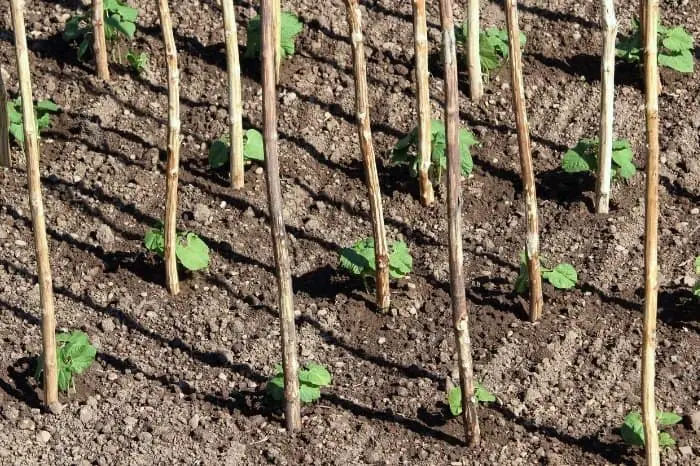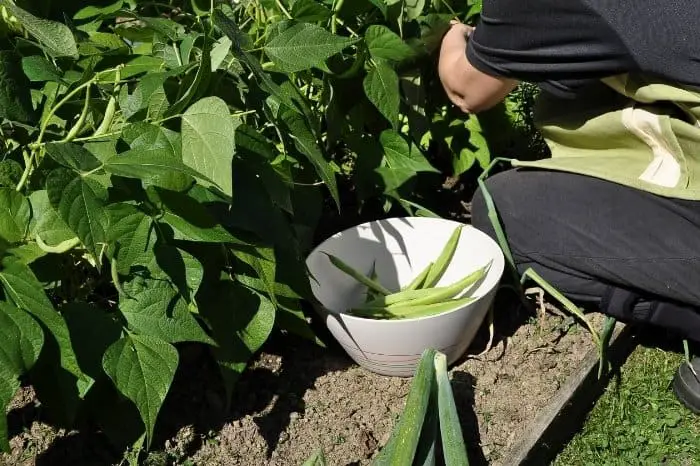Last Updated on March 30, 2022
Getting to know how far apart to plant your pole beans is one step to achieving maximum bean yields. Pole beans grow tall on climbing vines and it’s crucial you give them the appropriate spacing for the ease of gardening.
Growing beans plants in your garden will offer you great benefits such as a large quantity of yield. You also enjoy their amazing flavor and pleasant health benefits.
Proper spacing of pole beans gives you the ease of harvesting during the end of their bountiful harvest time. So, let’s find out how far apart to plant our pole beans.
Planting Pole Beans
Pole bean is a type of green beans crop. Generally, there are two types of green beans growing styles you can plant and they are pole and bush. Pole beans grow about 5 to 6 feet or even more. Therefore, pole beans require trellis or staking. On the other hand, bush beans will only grow about one foot or two feet.
These two green beans are all climbers and both require slightly different care. But in this article, we will be focusing more on pole beans. Let’s go further to know when is the best time to grow pole beans.
When To Plant Pole Beans
Pole beans should be planted after the danger of frost has elapsed. Thus, they can be planted around spring or early summer.
Pole Bean Planting Instructions
It’s pretty easy planting pole beans and you will enjoy a great harvest if you plant them the right way. Below are the steps to planting them:
Step 1- Sow your seeds
Beans generally are tender legumes. They don’t thrive well when transplanted because of their fragile roots. Therefore, germinating their seeds indoors may not be advisable.
So, the best way to plant your pole beans is to sow them directly into your soil. Make sure you push the seeds into the soil to about one or one and a half inches deep.
Step 2- Pole Beans Spacing
How far apart you should plant your pole beans seeds should be about 4 to 8 inches to about 3 or 4 seeds. For rows, also plant about 3 to 4 seeds and space them 2 to 3 feet apart.

Step 3- Temperature
Generally, green seeds are warm-weather crops and will do well in air temperature around 65 to 80 degrees Fahrenheit. Temperature is one crucial factor to consider when planting pole beans. The soil temperature in your garden should be around 50 to 60 degrees Fahrenheit. Also, the surrounding air should be around this temperature range. This will promote quick germination and prevent root rot.
Step 4- Trellis or teepee support
As your pole beans grow tall or vertically, they will require support. Thus, your pole beans will need trellis or teepee for support. If you want to make use of a teepee, obtain about 3 long pole branches and they should be approximately 6 to 7 feet tall. Tie these 3 long poles together at the top and spread out the base of the support to form a circle.
Once your poles begin to grow tall and vines grow up, tie them up to the pole. This way, you are able to train your pole beans to continue twirling around the pole throughout their growing season.
More Tips To Growing Pole Beans
-
Use Excellent Draining Soil: The soil you will be using to grow your pole beans should be well-draining. Well-draining soil will help prevent root rot and powdery mildew. They should also be filled with lots of organic amendments so you can enjoy bountiful yield at the end of the harvest.
-
Sunlight: Supply your pole beans with a full direct sun of about 6 to 8 hours per day. The temperature should be around 60 degrees Fahrenheit preferably. However, avoid too high temperatures as this can predispose your pole beans flower to start dropping. Therefore, whenever there is high heat, we recommend using row covers to shield your beans plant.
Orgrimmar 26 PCS 48″ Garden Support Stakes Plastic Coated Deformable Climbing Plant Trellis
-
Water Appropriately: Your pole beans need to be watered the right way and avoid overwatering. Watering should be applied directly to the soil to maintain good moisture and avoid drying out of the soil. Water 2 inches deep every week.
-
Mulching: We recommend mulching your soil to your bean plant. This will maintain warm soil, prevent drying out of the soil and also minimize weed. So, your plant can flourish and produce great yields.
-
Soil pH: The appropriate soil pH for pole beans is slightly acidic and the pH should be around 6.0.
-
Nutrient Application: Your pole beans will require a bit of fertilizer. You should add your fertilizer before planting your pole beans.
-
Pest & Disease Control: You can prevent diseases such as mildew by maintaining adequate air circulation between vines. Whenever you spot big insects, you can simply pick them off by hand. Then aphids can be removed by water or using neem oil.
Harvesting Pole Beans
Bean plants tend to produce bountiful yields and you can obtain a yield of several pounds of beans from just a single bean plant. For pole beans most varieties, you should expect your first harvest around 60 to 70 days.
You can start to harvest your pole beans once you notice the pods are full and swollen. Ideally, you should pick your beans every 3 to 5 days as this will help prevent you from harvesting older beans. Older beans tend to be woody and bitter.

We encourage you to harvest your pole beans consistently as this will encourage new flowers. This will also enhance your vines to live longer.
How far apart are bean poles?
When planting bean seeds, it is best to space the rows about 1/2 the length of a bean seed. For example, if the row spacing is 6 inches and the seeds are about 1/4 inch long, then the space between the rows should be 3 inches. Seeds should be planted about twice as deep as they are wide.
How tall should pole bean trellis?
A six feet trellis should be fine.
What should not be planted near pole beans?
Pole beans are fairly easy to grow and are a great crop to have for a small garden.
Pole beans are a great nitrogen fixing crop. They will help to fix some of the nitrogen in the soil and convert it to nitrates that can be used by the crops you plant next. Pole beans are often planted as a cover crop after harvest and they can be pulled or cut at ground level. If you have a large area, you could consider planting a couple of different varieties.
However, onions, garlic and chives should not be planted near pole beans.
Will pole beans climb string?
They'll climb, but not much. If you plant them right next to the supports, then they won't grow taller than 2 feet.If you use trellis supports, you could probably get them to grow a little taller than that.
Can you grow pole beans on a fence?
If you have a fence (wood or metal) and the pole beans are only planted within the fence then they should be fine. They should not grow to high. If the fence is too low it might be hard for them to climb up.
Why are my pole beans not climbing?
Some varieties will climb if they're in containers. You may need to stake them. Or transplant into larger containers so they'll have room to grow. If they aren't climbing, it's probably because they've been transplanted and the roots haven't established yet. I'd keep them for another week or two, then take a few out and look at the roots.
It might be a matter of the bean seeds being in the ground too long.
If there's no soil movement, you need to get the soil moving. If you have any good tools for that (e.g. spade), then start digging, turn over the soil, till it down, etc.
Conclusion On How Far Apart To Plant Pole Beans
How far apart are bean poles?
When planting bean seeds, it is best to space the rows about 1/2 the length of a bean seed. For example, if the row spacing is 6 inches and the seeds are about 1/4 inch long, then the space between the rows should be 3 inches. Seeds should be planted about twice as deep as they are wide.
How tall should pole bean trellis?
A six feet trellis should be fine.
What should not be planted near pole beans?
Pole beans are fairly easy to grow and are a great crop to have for a small garden.
Pole beans are a great nitrogen fixing crop. They will help to fix some of the nitrogen in the soil and convert it to nitrates that can be used by the crops you plant next. Pole beans are often planted as a cover crop after harvest and they can be pulled or cut at ground level. If you have a large area, you could consider planting a couple of different varieties.
However, onions, garlic and chives should not be planted near pole beans.
Will pole beans climb string?
They'll climb, but not much. If you plant them right next to the supports, then they won't grow taller than 2 feet.If you use trellis supports, you could probably get them to grow a little taller than that.
Can you grow pole beans on a fence?
If you have a fence (wood or metal) and the pole beans are only planted within the fence then they should be fine. They should not grow to high. If the fence is too low it might be hard for them to climb up.
Why are my pole beans not climbing?
Some varieties will climb if they're in containers. You may need to stake them. Or transplant into larger containers so they'll have room to grow. If they aren't climbing, it's probably because they've been transplanted and the roots haven't established yet. I'd keep them for another week or two, then take a few out and look at the roots.
It might be a matter of the bean seeds being in the ground too long.
If there's no soil movement, you need to get the soil moving. If you have any good tools for that (e.g. spade), then start digging, turn over the soil, till it down, etc.
Growing pole beans will be an awesome addition to your garden. How far apart you should plant your pole beans should be around 4 to 8 inches for 3 to 4 seeds. While growing in rows, you should plant about 3 to 4 seeds and space them 2 to 3 feet apart. Remember to always support your climbing beans with stakes or trellis.

Eunice is an enthusiastic gardener with a passion for growing beautiful flowers. She loves nothing more than spending time in her garden, tending to her plants and enjoying the outdoors. Eunice has been gardening for over 15 years and has developed a unique style of landscaping that is both practical and aesthetically pleasing. She is especially fond of growing roses and enjoys experimenting with different varieties and colors. Eunice takes great pride in her garden and often shares the fruits of her labor with friends and family. In her spare time, she enjoys reading gardening magazines and attending local horticulture events. Eunice is passionate about her hobby and is always eager to share her knowledge and experience with others.

